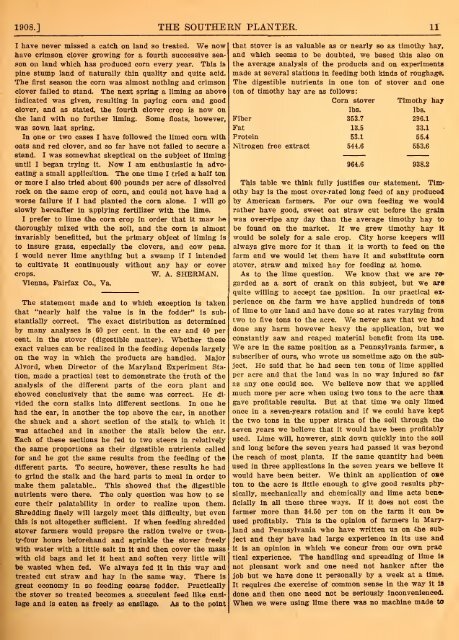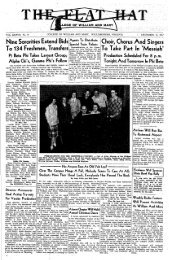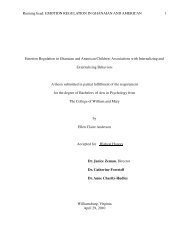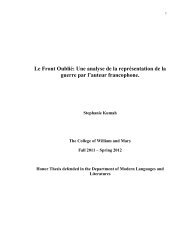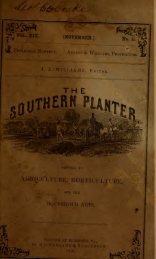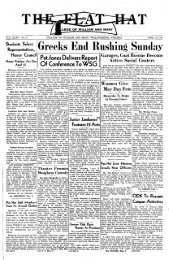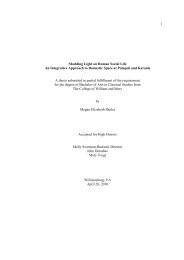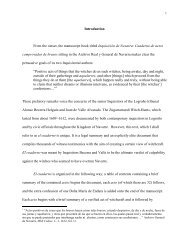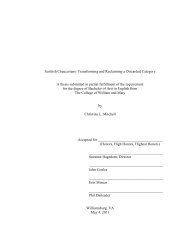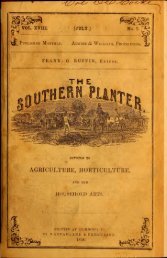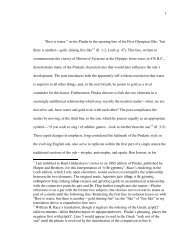Southern planter - The W&M Digital Archive
Southern planter - The W&M Digital Archive
Southern planter - The W&M Digital Archive
You also want an ePaper? Increase the reach of your titles
YUMPU automatically turns print PDFs into web optimized ePapers that Google loves.
1908.] THE SOUTHERN PLANTER. 11<br />
I have never missed a catch on land so treated. We now<br />
have crimson clover growing for a fourth successive season<br />
on land which has produced corn every year. This is<br />
pine stump land of naturally thin quality and quite acid.<br />
<strong>The</strong> first season the corn was almost nothing and crimson<br />
clover failed to stand. <strong>The</strong> next spring a liming as above<br />
indicated was given, resulting in paying corn and good<br />
clover, and as stated, the fourth clover crop is now on<br />
the land with no further liming. Some floats, however,<br />
was sown last spring.<br />
In one or two cases I have followed the limed corn with<br />
oats and red clover, and so far have not failed to secure a<br />
stand. I was somewhat skeptical on the subject of liming<br />
until I began trying it. Now I am enthusiastic in advo-<br />
cating a small application. <strong>The</strong> one time I tried a half ton<br />
or more I also tried about 600 pounds per acre of dissolved<br />
rock on the same crop of corn, and could not have had a<br />
worse failure if I had planted the corn alone. I will go<br />
slowly hereafter in applying fertilizer with the lime.<br />
I prefer to lime the corn crop in order that it mar be<br />
thoroughly mixed with the soil, and the corn is almost<br />
invariably benefitted, but the primary objeot of liming is<br />
to insure grass, especially the clovers, and cow peas.<br />
I would never lime anything but a swamp if I intended<br />
to cultivate it continuously without any hay or cover<br />
crops. W. A. SHERMAN.<br />
Vienna, Fairfax Co., Va.<br />
<strong>The</strong> statement made and to which exception is taken<br />
that "nearly half the value is in the fodder" is substantially<br />
correct. <strong>The</strong> exact distribution as determined<br />
by many analyses is 60 per cent, in the ear and 40 per<br />
cent, in the stover (digestible matter). Whether these<br />
exact values can be realized in the feeding depends largely<br />
on the way in which the products are handled. Major<br />
Alvord, when Director of the Maryland Experiment Sta-<br />
tion, made a practical test to demonstrate the truth of the<br />
analysis of the different parts of the corn plant and<br />
showed conclusively that the same was correct. He divided<br />
the corn stalks into different sections. In one he<br />
had the ear, in another the top above the ear, in another<br />
'the shuck and a short section of the stalk to> which it<br />
was attached and in another the stalk below the ear.<br />
Each of these sections he fed to two steers in relatively<br />
the same proportions as their digestible nutrients called<br />
for and he got the same results from the feeding of the<br />
different parts. To secure, however, these results he had<br />
to grind the stalk and the hard parts to meal in order to<br />
make them palatable.. This showed that the digestible<br />
nutrients were there. <strong>The</strong> only question was how to se<br />
cure their palatability in order to realize upon them.<br />
Shredding finely will largely meet this difficulty, but even<br />
this is not altogether sufficient. If when feeding shredded<br />
stover farmers would prepare the ration twelve or twen-<br />
ty-four hours beforehand and sprinkle the stover freely<br />
with water with a little salt in it and then cover the mass<br />
with old bags and let it heat and soften very little will<br />
be wasted when fed. We always fed it in this way and<br />
treated cut straw and hay in the same way. <strong>The</strong>re is<br />
great economy in so feeding coarse fodder. Practically<br />
the stover so treated becomes a succulent feed like ensi-<br />
lage and is eaten as freely as ensilage. As to the point<br />
that stover is as valuable as or nearly so as timothy hay,<br />
and which seems to be doubted, we based this also on<br />
the average analysis of the products and on experiments<br />
made at several stations in feeding both kinds of roughage.<br />
<strong>The</strong> digestible nutrients in one ton of stover and one<br />
ton of timothy hay are as follows:<br />
Corn stover Timothy hay<br />
lbs. lbs.<br />
Fiber 353.7 296.1<br />
Fat 13.5 33.1<br />
Protein 53.1 55.4<br />
Nitrogen free extract 544.6 553.6<br />
964.6 938.2<br />
This table we think fully justifies our statement. Timothy<br />
hay is the most over-rated long feed of any produced<br />
by American farmers. For our own feeding we would<br />
rather have good, sweet oat straw cut before the grain<br />
was over-ripe any day than the average timothy hay to<br />
be found on the market. If we grew timothy hay it<br />
would be solely for a sale crop. City horse keepers will<br />
always give more for it than it is worth to feed on the<br />
farm and we would let them have it and substitute corn<br />
stover, straw and mixed hay for feeding at home.<br />
As to the lime question. We know that we are regarded<br />
as a sort of crank on this subject, but we are<br />
quite willing to accept the position. In our practical ex-<br />
perience on the farm we have applied hundreds of tons<br />
of lime to our land and have done so at rates varying from<br />
two to five tons to the acre. We never saw that we had<br />
done any harm however heavy the application, but we<br />
constantly saw and reaped material benefit from its use.<br />
We are in the same position as a Pennsylvania farmer, a<br />
subscriber of ours, who wrote us sometime ago on the sub-<br />
ject. He sadd that he had seen ten tons of lime applied<br />
per acre and that the land was in no way injured so far<br />
as any one could see. We believe now that we applied<br />
much more per acre when using two tons to the acre tham<br />
gave profitable results. But at that time we only limed<br />
once in a seven-years rotation and if we could have kept<br />
the two tons in the upper strata of the soil through the<br />
seven years we believe that it would have been profitably<br />
used. Lime will, however, sink down quickly into the soil<br />
and long before the seven years had passed it was beyond<br />
the reach of most plants. If the same quantity had been<br />
used in three applications in the seven years we believe it<br />
would have been better. We think an application of one<br />
ton to the acre is little enough to give good results phy-<br />
sically, mechanically and chemically and lime acts bene-<br />
ficially in all these three ways. If it does not cost the<br />
farmer more than $4.50 per ton on the iarm it can be<br />
used profitably. This is the opinion of farmers in Mary-<br />
land and Pennsylvania who have written us on the subject<br />
and they have had large experience in its use and<br />
it is an opinion in which we concur from our own prac<br />
tical experience. <strong>The</strong> handling and spreading of lime is<br />
not pleasant work and one need not hanker after the<br />
job but we have done it personally by a week at a time.<br />
It requires the exercise of common sense in the way it ia<br />
done and then one need not be seriously inconvenienced.<br />
When we were using lime there was no machine made to


